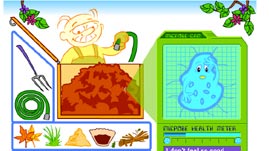Teachers' Domain - Digital Media for the Classroom and Professional Development
User: Preview

Source: Keep America Beautiful, Inc.
Yard and food wastes make up nearly one-third of the waste stream in the United States, most of which gets put in landfills or incinerated. Did you know that by simply combining some basic elements — organic waste, soil, water, and air — you can create ideal conditions for recycling these wastes naturally? This interactive activity from Keep America Beautiful, Inc. details what composting is and the roles that soil microbes, oxygen, and moisture play in this process. A game challenges users to start and maintain their own virtual compost pile.
Composting is the transformation of organic material through decomposition into a soil-like material called compost or humus. It is an inexpensive and effective way to both reduce household waste and save dwindling landfill space. What's more, composting converts waste into something useful: Compost added to topsoil can improve the soil's structure and overall chemistry, increase beneficial microbial activity, and enhance the soil's ability to retain moisture.
On close inspection, a compost pile is a complex community of living organisms. Soil invertebrates, such as earthworms, millipedes, and sow bugs, reduce organic matter into smaller pieces. Microbes — the bacteria and fungi responsible for most of the decomposing — then take over.
Organic materials left in a pile will eventually decompose. But actively maintaining the pile speeds the process. Three primary factors influence the speed at which composting occurs: oxygen, water, and temperature. Periodically turning over the layers with a pitchfork exposes the underlying surfaces to the air. This is important because microbes require oxygen to break down organic matter. Because microbes can only process organic molecules dissolved in water, compost piles must also contain adequate moisture. However, if the pile is too wet, aeration is hindered and nutrients leach out, slowing decomposition. Decomposing bacteria work most efficiently in temperatures around 55-60°C (130-140°F). Turning a pile releases trapped heat, keeping the temperature from rising too high. And making sure the pile is not too wet or too dry also aids in regulating the temperature.
Maintaining the proper carbon-to-nitrogen ratio (ideally, 30:1) is essential to successful composting. Too little nitrogen, and the pile will lack the ability to digest the food provided by carbon sources, including dried leaves. Too much nitrogen, however, will generate pungent ammonia gas. Knowing which household wastes to add or omit is essential to maintaining a productive pile. For example, some materials, like clippings from chemically treated lawns, can kill the microbes and should not be added. On the other hand, sawdust is an excellent source of carbon and should be occasionally added if available. Fruit and vegetable peelings represent good sources of nitrogen.
A sweet, earthy smell and warmth rising from the pile are signs that a compost pile is functioning and that the finished product — soil that is black or dark brown in appearance and smooth or crumbly in texture — may soon be ready. Typically, at least half of what gets added to a pile decomposes and is no longer recognizable within two to six weeks.
 Loading Standards
Loading Standards Teachers' Domain is proud to be a Pathways portal to the National Science Digital Library.
Teachers' Domain is proud to be a Pathways portal to the National Science Digital Library.
